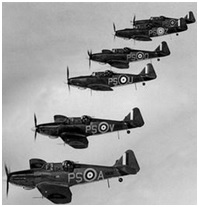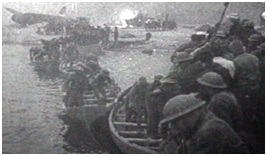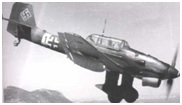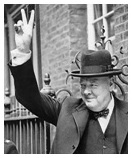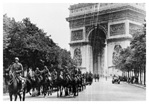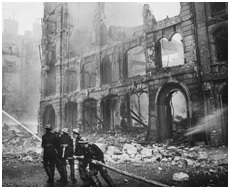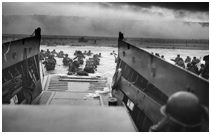|
 |
|
 |
The Battle of Britain - Leadership and Strategy The Battle of Britain (1940)
Famous for...
When did it happen? 10th July – 31st October, 1940 When Britain and its empire stood alone against Nazi Germany after the:
Key events before the battle
30th January 1933 Adolf Hitler becomes leader or Germany.
29th September 1938 The Munich Agreement, a peace agreement between:
Chamberlain declares that there will be “peace in our time”.
23rd August 1939 Germany and Russia (then called the Soviet Union) sign a non-aggression agreement.
3rd September 1939 Britain and France declare war on Germany after the German invasion of Poland on September 1st The Germans use Blitzkrieg with:
These tactics are also used to defeat France in June 1940 (see below).
January 1940 Bletchley Park code breakers decipher the German Enigma code.
10th May 1940 Winston Churchill (pictured right on May 20th with his famous 'V' sign for victory) succeeds Neville Chamberlain as British prime minister.
27th May - 4th June 1940 Dunkirk - 338,000 British and French troops are evacuated from Dunkirk in north-eastern France.
14th June 1940 The Germans enter Paris (pictured right). Britain has lost half its fighter planes trying unsuccessfully to defend France.
3rd July 1940 Britain destroys the French fleet at Oran in north Africa, signalling its determination to fight.
Key people
British prime minister.
Hugh Dowding Chief of the British fighter planes (called Fighter Command) - see below.
Keith Park Head of 11 Group, the RAF fighter stations defending south-east England.
Lord Beaverbrook Churchill’s minister for aircraft production.
Reginald Mitchell (pictured right) Designer of the Spitfire, Britain’s best fighter plane.
Sydney Camm (pictured right) Designer of the Hurricane, Britain’s other ace fighter.
Robert Watson-Watt (pictured right) Scottish inventor of radar.
German leader.
Hermann Goering Head of the Luftwaffe (the German air force).
Albert Kesselring (pictured right) Head of German fighter planes in north-eastern France.
The fighter pilots The pilots were the heroes (on both sides).
The opposing air forces (around 9th August 1940) Britain
Germany
Key events in the battle
June-September Britain exceeds the German production of fighters by 1,900 to 775.
12th August- 6th September German bombing of radar stations and airfields.
25/26th August British night time bombing of Berlin. 7th September Germans start bombing London in retaliation, the start of the Blitz (pictured right) which:
During the Blitz, Londoners are forced to shelter in the underground (or subway). 13th September Buckingham Palace bombed, where King George VI (pictured right) lives. This won him public support in the bombed areas like the East End in London (up until then he had been booed).
15th September Decisive British victory with 25 British and 60 German planes shot down (now called Battle of Britain Day) This led to Hitler’s indefinite postponement of invasion on 17th September.
Why did Britain win the Battle of Britain?
He turned Britain into a united nation of all conquering heroes through his:
2. Hugh Dowding The Scottish head of Fighter Command, Hugh Dowding (nicknamed “Stuffy”), pictured right, was a hero because of his:
But sadly Dowding was dismissed in November 1940 because of his unsuccessful handling of the German night bombing.
3. Keith Park Park (pictured right) , a New Zealander, was the brilliant commander of 11 Group, responsible for defending south-east England. He inspired his pilots through his:
His strategy of quickly attacking the enemy in single squadrons was very successful, but
criticized by... Trafford Leigh-Mallory (commander of 12 Group, responsible for the Midlands, pictured right), who supported “Big Wing” - 3 to 5 squadrons attacking together. His bitter dispute with Park contributed to Park’s dismissal in November 1940.
4. Poor German leadership Goering (pictured right) and Hitler made serious mistakes:
5. The Spitfire and Hurricane The Hurricane was sturdy and reliable. But the Spitfire was quicker, more manoeuvrable, and most feared by the Germans. The best German fighter was the Messerschmitt 109, pictured right, but its range was limited (it could only fly over Britain for 30 minutes).
The designers of the Spitfire (Reginald Mitchell), Hurricane (Sydney Camm) and their Rolls-Royce Merlin engine (Ernest Hives, pictured right) combined:
The test pilot, Ralph Sorley, pictured right, crucially insisted the Spitfire and Hurricane should have eight machine guns instead of their original four.
The dynamic government minister for aircraft production, Lord Beaverbrook (pictured right
below):
6. Teamwork The British pilots worked brilliantly with the people on the ground:
7. Morale and purpose The pilots’ morale was fantastic and they, like everybody else in Britain, wanted to defeat Hitler. They found spiritual fulfilment in having something worthwhile to die for. People were also cheered up by
8. Code breaking A team at Bletchley Park in Buckinghamshire (led by Alan Turing, pictured right) deciphered the German Enigma code in January 1940. So Britain knew exactly what the Germans were doing.
9. Radar and new technology A team at Bawdsey Manor in Suffolk (led by the inspirational Scot, Robert Watson-Watt)
developed radar which crucially detected German planes. This project was encouraged by the government scientist, Henry Tizard,pictured right In August 1940 (with Churchill’s approval), Tizard sent all of Britain’s technological defence secrets to the Americans, so that they could develop them further (called the Tizard Mission).
10. Pilots Britain’s pilots (called “the few” by Churchill) were skilled and courageous. 414 were killed in the battle, and they included men from:
Their morale was much higher than the German pilots who:
Eight pilots Douglas Bader (242 Squadron, Coltishall, Norfolk) - 1910-82 Made famous by the 1956 film, Reach for the Sky, Bader (pictured right) lost his legs in a plane crash in 1931 as a young RAF pilot. In the Battle of Britain, he inspired the Canadians in his Hurricane squadron with his:
He proposed the controversial “Big Wing” idea of several squadrons flying together. Captured in 1941, he was sent to Colditz, the famous German prisoner of war camp.
Alan (“Al”) Deere (54 Squadron, Hornchurch, East London) - 1917-95 A New Zealand Spitfire ace (pictured right), his 1959 autobiography was called Nine Lives, because he had several narrow escapes including a collision with a German fighter on July 9th. He courageously overcame:
He was helped by the love of Joan, who married him in September 1945.
Bob Doe (234 Squadron, Middle Wallop, Hampshire) - 1920-2010 The third most successful pilot in the Battle of Britain, pictured right, shooting down 14 German planes by the end of 1940. His self-belief was just as important as his flying ability. He said: “If you believe in yourself and believe in what you are doing, then you are twice as strong as if you don’t”. In January 1945 he needed 22 plastic surgery operations after a plane crash.
Roger (“Sam”) Hall (152 Squadron, Middle Wallop, Hampshire) 1917-2002 He bravely overcame his constant fear of death, reflected in the title of his 1975 autobiography, Clouds of Fear. But, after the death of his close friend, “Scottie”, a New Zealand pilot, in 1942, he finally cracked and had to stop flying. He fully recovered (helped by his belief in God) and lived happily in Dover.
Adolph (“Sailor”) Malan (74 Squadron, Hornchurch, East London) - 1910-63 A South African, Malan (pictured right) was the best Battle of Britain pilot and a great leader because of his:
His tips for success in battle were:
He said: “Go in quickly. Punch hard. Get out!”
Richard Hillary (603 Squadron, Montrose, Scotland) - 1919-43 Australian pilot, who wrote about his wartime experiences in his book, The Last Enemy. His love affair with Mary Booker inspired him to overcome his:
He was one of the many “Guinea Pigs” who were given excruciatingly painful plastic surgery for their burns by Doctor Archie McIndoe (pictured right) .
Adolf Galland (1912-66) German fighter ace (pictured right) who
Werner Mölders (1913-41) Mölders (pictured right) was:
The results of victory in the Battle of Britain 1. D-Day The invasion of Western Europe from Britain (pictured right) - see D-Day.
2. Germany fighting on two fronts (when Hitler invaded Russia in 1941).
3. Bombing of Germany from Britain This bombing:
4. America’s increased support for Britain Americans (including President Franklin D. Roosevelt, pictured right) admired the courage of the British This made Roosevelt's declaration of war against Germany in 1941 much easier.
Key quotes by Churchill in 1940
We shall defend our island, whatever the cost may be. We shall fight on the beaches, we shall fight on the landing grounds, we shall fight in the fields and streets. we shall fight in the hills; we shall never surrender - June 4th (just after the evacuation of British and French troops at Dunkirk).
The Battle of France is over. I expect that the Battle of Britain is about to begin... Let us therefore brace ourselves to our duties, and so bear ourselves that, if the British Empire and its Commonwealth last for a thousand years, men will still say, ‘This was their finest hour’, - June 18th.
Never in the field of human conflict was so much owed by so many to so few. - 20th August (talking about the Battle of Britain).
Other key quotes
I had a feeling of the essential rightness of it all. He was dead and I was alive; it could so easily have been the other way round. - Richard Hillary , Australian Battle of Britain pilot.
Taking a Spitfire into the sky in September 1940 was like entering a dark room with a madman waving a knife behind your back. - Sailor Malan, Battle of Britain pilot.
Anyone who said he felt no fear in action was not telling the truth...The Germans were doing their level best to try and kill or maim you. - Al Deere, Battle of Britain pilot. I’m glad we’ve been bombed. It makes me feel I can look the East End in the face. - Queen Elizabeth, wife of King George VI (pictured right in 1939).
We do not want to be remembered as heroes, we only ask to be remembered for what we did....that's all. Bob Doe, Battle of Britain pilot. I regard it as a privilege to fight for all those things that make life worth living - freedom, honour and fair play. Bill Millington, pictured right, Australian Battle of Britain pilot.
I must therefore request that... not one fighter will be sent across the Channel however urgent and insistent the appeals for help may be. - Hugh Dowding (in a letter to Winston Churchill, 16th May, 1940).
No man in his RAF uniform failed to score. - comment on RAF sex appeal at the Café de Paris in London, a servicemen’s club.
|
|
|
||
|
|
|
||
|
||
| Copyright © wisdomtowin.com All Rights Reserved | ||
|

